

How to set a mouse trap. Tools for teams and teamwork. Survey Design Resource.pdf. Field Guide to Developing Quantiative Instruments.pdf. Top 10 questions for employee engagement surveys. Employee surveys may range from annual "epics" to monthly pulse surveys, but there is no one-size-fits-all version.
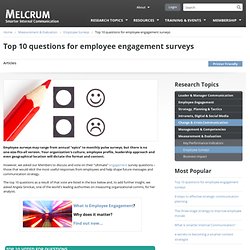
Your organization's culture, employee profile, leadership approach and even geographical location will dictate the format and content. However, we asked our Members to discuss and vote on their "ultimate" engagement survey questions – those that would elicit the most useful responses from employees and help shape future messages and communication strategy. The top 10 questions as a result of that vote are listed in the box below and, to add further insight, we asked Angela Sinickas, one of the world's leading authorities on measuring organizational comms, for her analysis.
Questions to ask in focus groups first. Introducing the Five Generation Workplace. Celebrating National Employee Appreciation Day Tomorrow is National Employee Appreciation Day, and yet only a small percentage of bosses and employers are taking tomorrow to formerly recognize, engage and celebrate their employee.
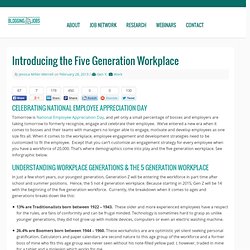
We’ve entered a new era when it comes to bosses and their teams with managers no longer able to engage, motivate and develop employees as one size fits all. When it comes to the workplace, employee engagement and development strategies need to be customized to fit the employee. Except that you can’t customize an engagement strategy for every employee when you have a workforce of 20,000. That’s where demographics come into play and the five generation workplace. Understanding Workplace Generations & the 5 Generation Workplace. Many Baby Boomers Reluctant to Retire. January 20, 2014 by Jim Harter and Sangeeta Agrawal This article is part of an ongoing series analyzing how baby boomers -- those born from 1946-1964 in the U.S. -- behave differently from other generations as consumers and in the workplace. The series also explores how the aging of the baby boomer generation will affect politics and well-being. WASHINGTON, D.C. -- True to their "live to work" reputation, some baby boomers are digging in their heels at the workplace as they approach the traditional retirement age of 65.
While the average age at which U.S. retirees say they retired has risen steadily from 57 to 61 in the past two decades, boomers -- the youngest of whom will turn 50 this year -- will likely extend it even further. Concerns about money likely play a significant role in explaining why so many baby boomers see themselves working longer. Engaged Boomers Slightly More Likely to Delay Retirement.
The Contributions of Immigrants and Their Children to the American Workforce and Jobs of the Future. SOURCE: AP/Jacquelyn Martin Edwin Munoz, who is originally from El Salvador, holds his daughter, Jocelyn, 5 months, up for a portrait at the end of the "Rally for Citizenship," a rally in support of immigration reform on Capitol Hill in Washington, Wednesday, April 10, 2013.
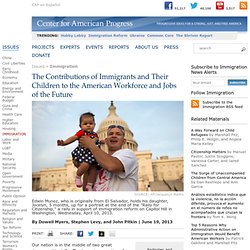
By Dowell Myers, Stephen Levy, and John Pitkin | June 19, 2013. Generations%20in%20the%20Workplace. Knowledge Center. Currently, the demographics of the labor force span four generations.
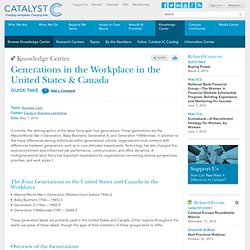
These generations are the Mature/World War II Generation, Baby Boomers, Generation X, and Generation Y/Millennials. Knowledge Center. Are You Ready to Manage Five Generations of Workers? - Jeanne C Meister and Karie Willyerd. By Jeanne C Meister and Karie Willyerd | 2:48 PM October 16, 2009 Does retirement look a little further off now than it did just a few years ago?
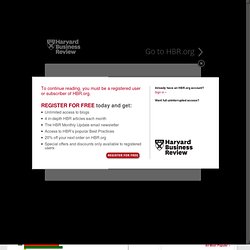
If you are over 62, odds are you’re putting off retirement at least two to three years, and you may even be planning on working beyond 70. If you’re over 50, and lost 40% or more of your nest egg, you are about twice as likely to delay retirement as those who lost less. According to the World Health Organization, men and women who are healthy at 60 will, on average, be physically capable of working until they are 74 and 77, respectively. Combine these statistics and the newest employees entering the workforce might not be joining their parents or grandparents, they might be joining their great-grandparents. This translates into a social phenomenon not yet witnessed: five generations are about to be working side by side. The chart below shows that Baby Boomers will cede the majority of the workforce by 2015 to the Millennials.
Younger managers rise in the ranks: survey quantifies management shift and reveals challenges, preferred workplace perks, and perceived generational strengths and weaknesses. New EY research to be discussed at upcoming event and webcast tied to launch of book that explores ways millennials and other generations can advance their careers today New York, September 3, 2013 /PRNewswire/ — EY released new research today that shows a significant shift in Generations Y and X moving into management roles in the past five years and provides context, in light of this shift, for managing the generational mix.
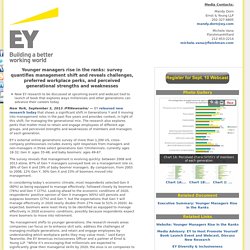
The research also explores perks that matter most to retain and engage employees of different age groups, and perceived strengths and weaknesses of members and managers of each generation. EY’s external online generations survey of more than 1,200 US, cross-company professionals includes evenly split responses from managers and non-managers in three select generations Gen Y/millennials: currently ages 18-32; Gen X: ages 33-48; and baby boomers: ages 49-67. There's a Generation Gap in Your Workplace. People say the Baby Boom generation, because of its size, always gets what it wants.

That may be true in many realms, but not in the workplace. Baby Boomers -- along with Generation X employees -- are distinctly less engaged at work than other generations. Baby Boomers have the lowest level of engagement and the highest level of active disengagement. The oldest and youngest workers in the American workplace are the most likely to be engaged, according to Gallup research. Traditionalists (born in 1945 or earlier) have the highest level of engagement at 41% engaged, followed by 33% for Millennials (born in 1981 or later).
The Multigenerational Workforce - Managing and Motivating a Multigenerational Workforce. Generation X Generation X encompasses the 44 to 50 million Americans born between 1965 and 1980.
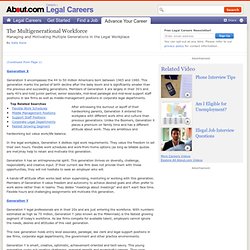
This generation marks the period of birth decline after the baby boom and is significantly smaller than the previous and succeeding generations. Members of Generation X are largely in their 30’s and early 40’s and hold junior partner, senior associate, mid-level paralegal and mid-level support staff positions in law firms as well as middle-management positions in corporate legal departments. Can We All Work Together? - Perspectives - Inside INdiana Business with Gerry Dick. Multiple (4 to be exact) generations working together in the business world.

In our personal lives we have always had individuals within the family unit that represent many generations (at least 2 if not 4 or 5). Therefore, most people know how to relate and communicate with people from other generations to accomplish goals and make decisions on a personal level. Then why (you may ask) don't we just carry these skills over to the workplace? Perhaps it is because the line of authority and ultimate decision maker is clearer in the family unit than the business environment, maybe it is because rarely, if ever, is the youngest generation in a position of authority or power over the older generation, or maybe it is because the multiple generations in a family often share the same basic value system. Working With Five Generations In The Workplace. Generations in the workplace: Winning the generation game. Generation X and The Millennials: What You Need to Know About Mentoring the New Generations.
Which of the following means the most to you?
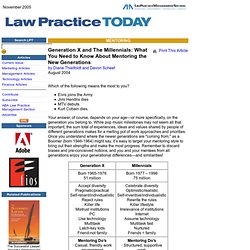
Elvis joins the Army. Jimi Hendrix dies MTV debuts. 10 Principles of Change Management. Updated: 10 Principles of Leading Change Management This classic guide to organizational change management best practices has been updated for the current business environment. To read the newest article, click here. Or, to watch a related video, click on the play button above. Way back when (pick your date), senior executives in large companies had a simple goal for themselves and their organizations: stability. Shareholders wanted little more than predictable earnings growth. What Is Change Management? - Prosci. Cost of Poor Internal Communications 2014. Grade Inflation: 5 Steps to Help Millennials Overcome Inflated Expectations.
Photo Credit: World.edu Grade inflation, which has been on the rise for over a decade is not doing anyone any favors – especially the students who leave college with inflated expectations and understandings of what is good work — it’s a long tail for Millennials and management alike, as managers deal with inflated expectations for recent graduates in the real world of business. When the most common grade awarded at Harvard is an A, something’s funky in the water – and businesses are left holding the bag. 7 communication tips for millennial leaders. In today's multigenerational, global, constantly changing world, communication skills—both oral and written—are more important than anything else you can bring to a job. You can't lead without good communication, and no matter how technical or virtual the workplace becomes, your ability to speak and write well will differentiate you from your peers and determine your ability to advance and succeed. Moreover, in every survey that asks about millennials, employers say communication skills are what they want the most.
They also say millennials tend to lack those skills. SJI_SoftSkillsReport_vFINAL_1.17.13. Hire For Attitude.